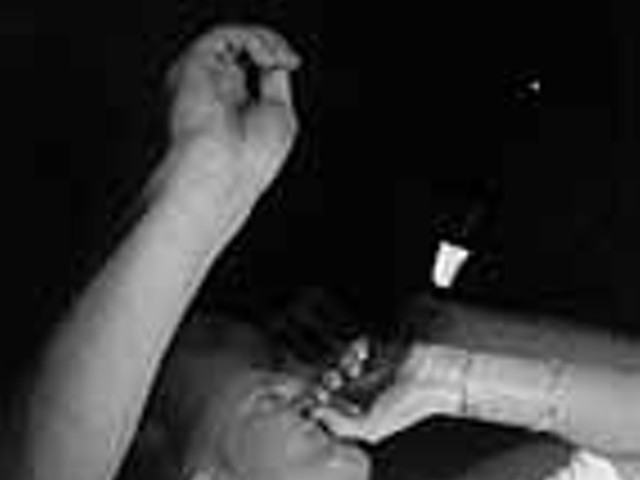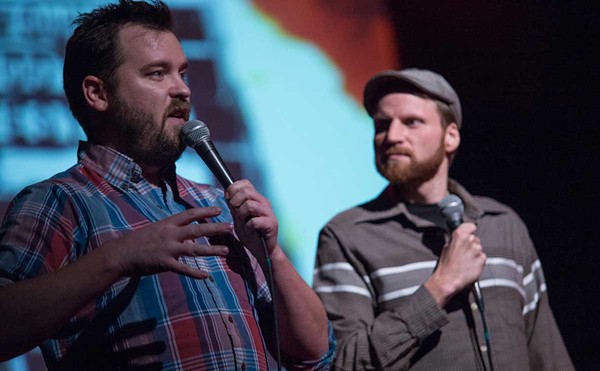Imagine scenes from the medieval play Everyman – a ritual allegory with characters called Death, Beauty, Knowledge and Good Deeds – frozen into swirling, whacked-out images by filmmaker David Lynch (Blue Velvet, Twin Peaks) for the cover of a Grateful Dead album. But that doesn’t really nail it.
Dada, surrealism or other 20th century brands of deviance don’t quite prepare us for the woodcuts of one Thomas A. Huck. Emitting an ageless aura of fate and dementia, the works in Two Weeks in August: 14 Rural Absurdities, Huck’s exhibition at the Elaine L. Jacob Gallery, hearken back to the year 1500 when the late Middle Ages were fading into the early Renaissance. And a whole posse of visual artists – among them, Albrecht Dürer, Hans Holbein the Younger and Hieronymus Bosch – were turning the terrors and obsessions of the time into works with titles like "The Dance of Death" and "The Apocalypse." Their images, done in series, have an enduring starkness emphasized by the black and white of the woodcut medium itself.
On the cusp of the year 2000, many miles and much weirdness and bloodshed later, from a small town in southeast Missouri, Huck now appears on the national scene. Consciously influenced by Dürer and the German expressionists, among others, this young horseman of the apocalypse has turned a hybrid-medieval-postmodern eye to the events of his rural American surroundings.
Though the true story behind Huck’s "Bed of Bones" (1996) seems weird enough – an old couple is discovered one day in a farmhouse bed surrounded by the stench and carcasses of their adopted dogs – the woodcut brings up so much more. In fact, its echoes of the "Death and the Maiden" motif – in which a lovely Lady was commonly represented lying down with the skeleton of Death on a bed of Love – push the real-life facts into the background.
Instead, our attention is drawn to rows of bones like a bed of lettuce upon which two overripe human tomatoes have been laid out ever so creepily. The look on the lady’s face draws us in as accomplices to what we’re seeing. Her bedmate, who only has heavy-lidded eyes for his dame, seems on the brink of passing out. And between them, what’s that clenched in the black mutt’s jaws? ... a bone. Shades of doggy Texas chainsaw massacre!
Huck’s unusually large (by any century’s standards) woodcuts divide up into three categories. First, there’s the mammoth triptych, "Snacktime Marcy" (1998), with its feeding-frenzy visions of an out-of-control state of disgrace. Its down-home figures’ borderline psychotic grins of pleasure are almost unbearable to look at.
Then his "rural absurdities" series takes two different approaches to the picture plane: Either Huck anchors a composition on a strong central event – as in the reeking nightmare of "Bed of Bones," or he’ll establish four or five important locales of action within a picture, on the way to filling up every last centimeter, a Jackson Pollock-esque, all-over effect that’s as disturbing as maggots crawling over a rotting mindscape.
A great example of the latter is "Mad Dash for Cash" (1996). Ostensibly based on a real-life stock car race, this phantasmatic collision of flesh, metal, smoke and flames is a cubist docudrama gone bananas. Everywhere you turn, in every little nook and cranny of its visual riot, a detail or three hails your gaze.
Huck, at 28, finds himself on the threshold of some serious notoriety. Though raised and educated in the American heartland, where he teaches printmaking and drawing at the University of Missouri-Columbia, he’s now collaborating on a series of new works with Landfall Press in Chicago and finds himself representing the United States in a major exhibition in Amsterdam. And this summer he leaves for a residency at the Cité International des Arts in Paris.
Standouts in the Detroit show are: "Playland" (1996), depicting the grand opening of a small-town "Shark Burger" joint amid pandemonium in the surrounding streets; "Chili Dogs, Chicks and Monster Trucks" (1996), in which topless babes, beer, oversized pickups and a maddening crowd add up to cosmic chaos; and "Exhuming Moses" (1997), a gruesome states-rights tableau worthy of the Crypt Keeper.
Too freaky and detailed for a T-shirt, Huck’s creations nevertheless speak to us in a totally accessible, cartoonlike vocabulary on the way to some mighty scary conclusions. ’Cause if these are us – as in U.S. – then beam me up, Buddha!
George Tysh is Metro Times' arts editor. E-mail him at [email protected]



